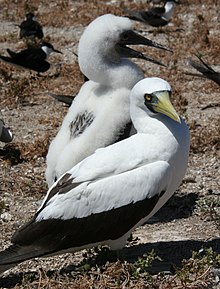Masked booby
| Masked booby | |
|---|---|
 |
|
| Austropacific masked booby (S. d. personata) with chick (background) | |
| Scientific classification | |
| Kingdom: | Animalia |
| Phylum: | Chordata |
| Class: | Aves |
| Order: | Suliformes |
| Family: | Sulidae |
| Genus: | Sula |
| Species: | S. dactylatra |
| Binomial name | |
|
Sula dactylatra (Lesson, 1831) |
|
| Subspecies | |
|
see text |
|
see text
The masked booby (Sula dactylatra) is a large seabird of the booby family, Sulidae. This species breeds on islands in tropical oceans, except in the eastern Atlantic; in the eastern Pacific it is replaced by the Nazca booby, Sula granti, which was formerly regarded as a subspecies of masked booby. It is also called the masked gannet or the blue-faced booby.
A conspicuous and distinct gannet-like species, it was proposed for separation to a monotypic subgenus Pseudosula, but the Nazca booby and as it seems also the brown booby (S. leucogaster) are quite close relatives.
First described by French naturalist René-Primevère Lesson in 1831, the masked booby is one of six species of booby in the genus Sula. The Nazca booby (S. granti) was formerly regarded as a subspecies. There are four subspecies, none of which is separable at sea:
This is the largest booby, at 74–91 cm (29–36 in) long, with a 137–165 cm (54–65 in) wingspan and 1.2–2.35 kg (2.6–5.2 lb) weight. Adults are white with pointed black wings, a pointed black tail, and a dark grey facemask. The sexes are similar, but the male has a yellow bill, and the female's is greenish yellow; during the breeding season they have a patch of bare, bluish skin at the base of the bill. Juveniles are brownish on the head and upperparts, with a whitish rump and neck collar. The underparts are white. Adult plumage is acquired over two years.
The masked booby is silent at sea, but has a reedy whistling greeting call at the nesting colonies. While on the breeding grounds, these birds display a wide range of hissing and quacking notes.
Masked boobies are spectacular divers, plunging diagonally into the ocean at high speed. They mainly eat small fish, including flying fish. This is a fairly sedentary bird, wintering at sea, but rarely seen far away from the breeding colonies. However, Caribbean birds occasionally wander north to warm southern Gulf Stream waters off the eastern seaboard of the United States. More remarkably, there have been three western Palaearctic records of masked booby, presumably dactylatra, all from Spanish waters, although one of these also entered French territorial areas.
...
Wikipedia

